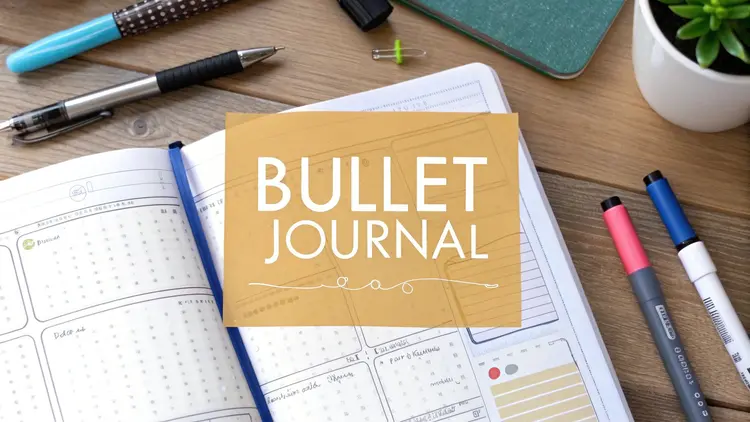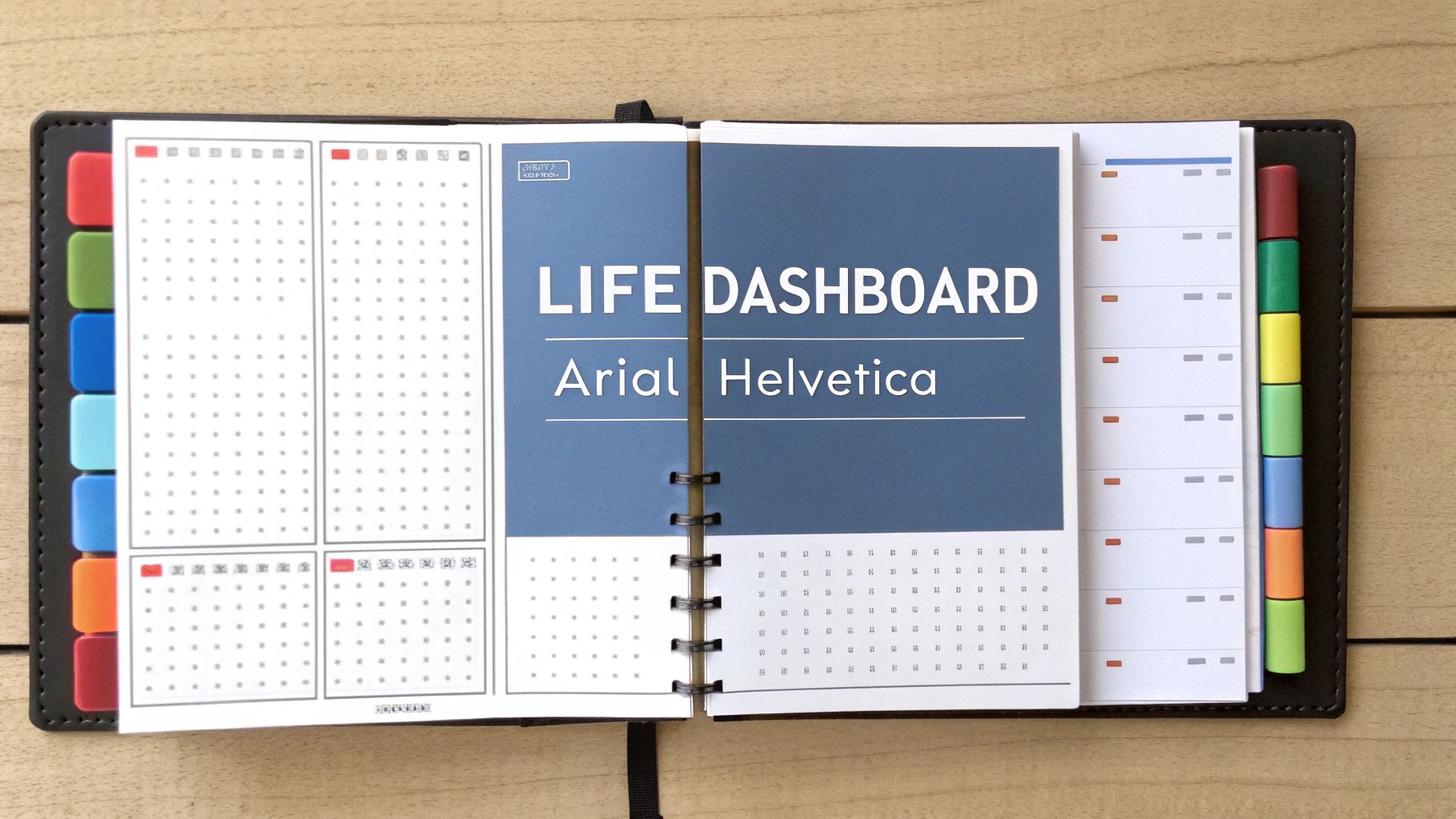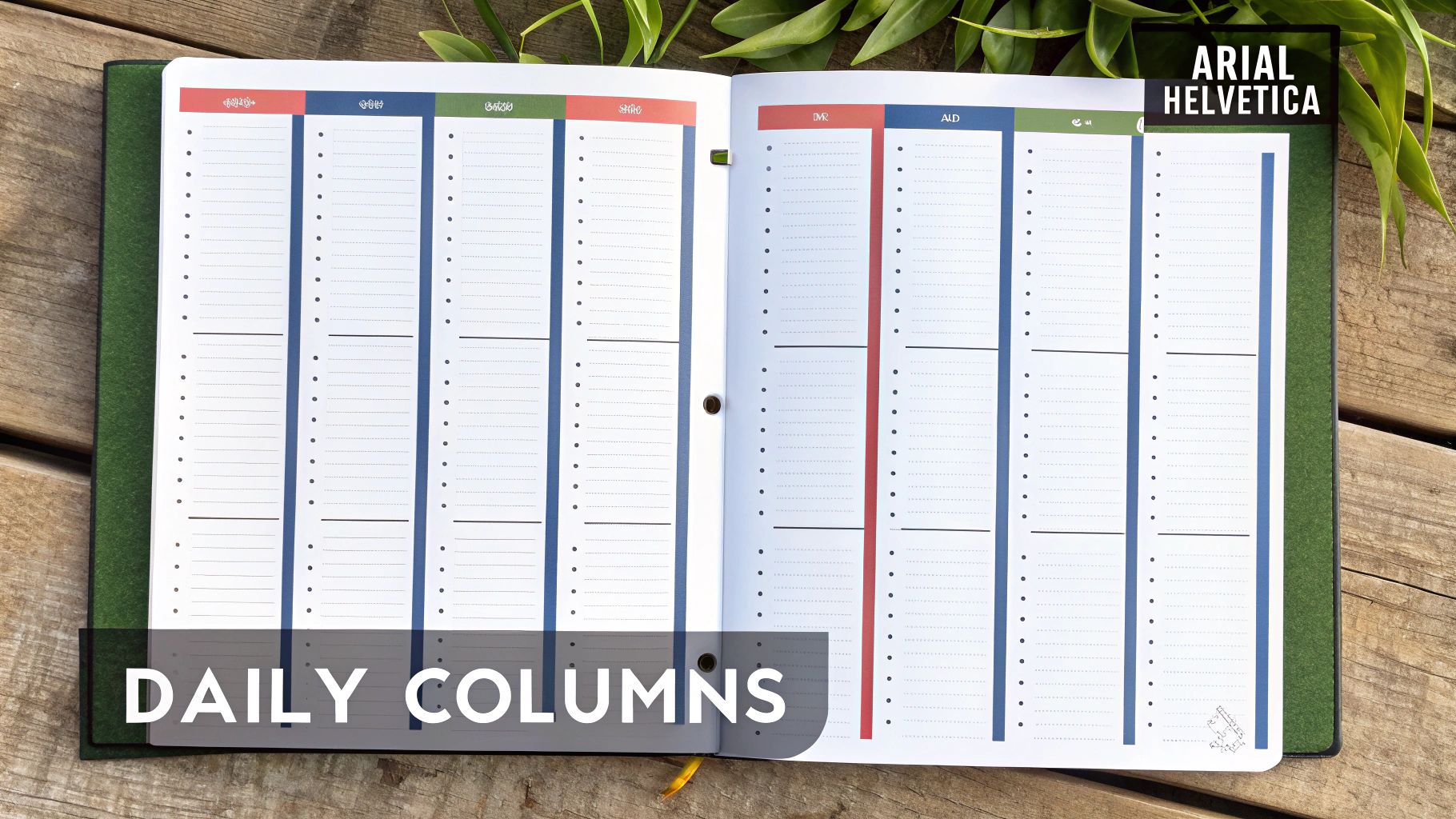A well-organized week is essential for a productive life, especially for busy entrepreneurs, solopreneurs, content creators, and anyone juggling multiple priorities. Sometimes our to-do lists feel less like a roadmap and more like a chaotic jumble. That’s where the power of the bullet journal weekly spread comes in.
Evolving from the original bullet journal method created by Ryder Carroll, which emphasizes rapid logging and mindful organization, weekly spreads provide a dedicated space to visualize and manage your time. From minimalist trackers to elaborate artistic layouts, these customizable spreads offer a welcome alternative to rigid digital calendars and overflowing inboxes.
What makes a weekly spread truly effective? It’s the right balance of functionality and personalization. A great layout provides a clear overview of your week, incorporates task management, and allows for scheduling appointments. Ideally, it also includes space for notes, goals, and habit tracking – all tailored to your needs.
Think of your weekly spread as a personalized command center, a visual representation of your plans, and a powerful tool for achieving your goals. This isn’t just about checking things off a list; it’s about reclaiming your time, minimizing stress, and maximizing productivity.
Exploring Different Weekly Spread Ideas
In this article, we’ll explore a variety of weekly spread ideas for different planning styles, from minimalist and practical to artistic and expressive. Whether you’re looking to boost your productivity, embrace a more mindful approach to planning, or simply declutter your digital life, you’re in the right place. Get ready to discover the perfect weekly spread to transform your week and unlock your potential!
Classic Horizontal Layout: A Bullet Journal Staple
The Classic Horizontal Layout is a cornerstone of the bullet journaling world. It’s a go-to for beginners and experienced journalers alike. This simple design divides your weekly spread into seven horizontal rows, one for each day of the week. This gives you a clear overview of your schedule and tasks. It’s an excellent starting point for your bullet journaling journey, or if you just want a clean and efficient layout. It’s popular with busy entrepreneurs, solo business owners, content creators, and anyone looking to boost their productivity. This layout’s simplicity makes it easy to use and customize, offering a structured yet flexible way to manage your week.

Key Features and Benefits
- Seven horizontal sections: Each day has its own row, making daily planning straightforward.
- Equal space allocation: Gives each day equal importance, creating a balanced view of your week.
- Optional sidebar: A vertical section on the side can hold your weekly task list, goals, notes, or a mini-calendar. This keeps your daily rows focused on appointments and time-sensitive tasks.
- Simple grid or lined format: Works well with dotted grid or lined notebooks. Setup is minimal and requires very little measuring.
- Minimal design elements required: Its clean look reduces visual clutter and prioritizes function, ideal for those who appreciate minimalism.
Pros of the Horizontal Layout
- Easy setup: Minimal measuring and drawing makes it quick to set up.
- Highly readable: Clear daily divisions make it easy to see what’s happening each day.
- Efficient use of space: Makes the most of the page without feeling crowded.
- Versatile: Adaptable for various uses, from basic task lists to detailed daily schedules.
- Perfect for beginners: A great way to learn and use bullet journal principles.
Cons of the Horizontal Layout
- Limited space per day: May not work well for very busy schedules packed with tasks and appointments.
- Potential for monotony: Can feel repetitive if you don’t personalize it.
- Less creative freedom: Not as flexible for intricate designs compared to some other layouts.
- Not ideal for multiple categories per day: If you need to track work, personal, health, and other categories within each day, another layout might be better.
Tips for Implementation
- Use a ruler: Straight lines make your spread look neat and professional.
- Habit tracker: Add a small habit tracker at the bottom of each day to track your weekly goals.
- Color-coding: Use colors to differentiate task types or events for better visual organization.
- Weather icons: Small weather icons add a touch of personality and helpful information.
- Mini calendar: A small calendar helps you quickly check dates. You might like these [different ways to incorporate monthly calendars in your bullet journal].
The Layout’s Popularity
The Classic Horizontal Layout became really popular with the rise of the bullet journaling movement, thanks to Ryder Carroll, the Bullet Journal’s creator, and influencers like Amanda Rach Lee and Megan Rhiannon. Their minimalist, effective weekly spreads showed how practical and adaptable this layout is. Amanda Rach Lee’s minimalist spreads often use this layout and demonstrate its clean aesthetic. Ryder Carroll’s The Bullet Journal Method book also features versions of this design.
For more guidance on setting up your bullet journal and exploring other layouts, check out this article on Bullet Journal Set Up. This foundational layout is a great way to plan your week effectively. Whether you’re a busy entrepreneur, a content creator looking for organization, or someone searching for productivity tips, the Classic Horizontal Layout offers a clear, accessible way to a more productive week.
The Dutch Door: A Dynamic Bullet Journal Layout
The Dutch Door Layout, taking its name from those charming split doors seen in traditional Dutch architecture, offers a fresh and engaging way to organize your bullet journal weekly spread. It involves strategically cutting or folding your pages to create overlapping sections, giving you a glimpse of multiple parts of your journal at the same time. This clever trick often features a weekly overview on the top layer that stays visible while you browse your daily logs or other notes below.https://www.youtube.com/embed/_75gcNd-ur4
This layout has become incredibly popular among bullet journal fans, especially busy entrepreneurs, content creators, and those looking for powerful productivity tools. Why? Because it allows you to see both the big picture and the daily details simultaneously. Imagine having your weekly goals and appointments always in view while you tackle your daily to-do list – that’s the magic of the Dutch Door. This visual continuity is especially helpful for visual thinkers and anyone who wants a more streamlined and less cluttered planning system.
Inspiration and Evolution
The Dutch Door’s rise in popularity can be credited to creative innovators like Plant Based Bride, a YouTube creator who demonstrated its versatility for habit tracking, and Sunshine & Stationery, an Instagram influencer known for their beautifully nested Dutch door weekly spreads. Caitlin Da Silva, another bullet journal layout innovator, has also contributed to the evolution of this method. Their inventive uses have inspired countless others to try this dynamic layout, as discussed in this article about How Social Media Influenced Bullet Journaling.
Adaptability and Customization
The Dutch Door is highly adaptable to different page sizes and configurations. You could create a simple half-page fold to reveal daily entries under a weekly overview, or explore more intricate nested designs for multiple layers of information. This flexibility makes it perfect for both simple and more complex planning needs.
Pros and Cons of the Dutch Door
Here’s a quick rundown of the advantages and disadvantages:
Pros:
- Maximized Functionality: See your weekly, daily, and even monthly plans at a glance.
- Reduced Page-Flipping: Access related info without constantly flipping back and forth.
- Visual Interest: The layered design adds a cool, three-dimensional touch.
- Customizable: Tailor the layout to your specific needs and style.
- Ideal for Visual Thinkers: The constant visual overview helps with overall planning.
Cons:
- Page Cutting: Requires careful cutting, which could potentially damage your journal.
- Complexity: Takes more time to set up than basic layouts.
- Error Correction: Difficult to fix any cutting mistakes.
- Thin Pages: Not ideal for journals with thin, fragile pages.
- Bulkiness: Can make your journal thicker over time, especially with many layers.
Tips for Creating a Dutch Door
Here are a few helpful tips for getting started:
- Precise Cutting: Use a ruler and a sharp exacto knife for clean, straight cuts.
- Reversible Option: Fold instead of cutting for a non-permanent version.
- Consistent Cutting: Make templates to trace for consistent size and placement.
- Reinforced Edges: Use washi tape to reinforce cut edges and stop them from tearing.
- Start Simple: Begin with simple half-page cuts or folds before trying more complex designs.
Why Choose the Dutch Door?
The Dutch Door layout deserves a spot on this list because it offers a truly innovative and practical approach to weekly planning. By bringing together different planning horizons into a single, easily accessible spread, it boosts productivity, minimizes clutter, and adds a touch of creativity to your bullet journal. It’s a great option for those looking for productivity boosts and ways to improve their planning, offering a tangible solution. For additional digital tools, check out these Top 10 Productivity Apps to Complement Your Bullet Journal.
The Timeline Layout: A Visual Approach to Weekly Planning
The Timeline Layout is a popular format for bullet journal weekly spreads. It provides a highly visual and structured approach to time management. Think of it as a traditional planner, but within your bullet journal. This layout represents each day as a vertical timeline, with the hours of the day running from top to bottom. Days are arranged in columns across the spread, creating a grid that helps you visualize your weekly schedule.

This method is particularly helpful for visual learners who appreciate seeing their schedule at a glance. It offers a clear overview of commitments, allowing you to quickly identify free time and avoid over-scheduling. This makes it a great tool for busy individuals, entrepreneurs, and solo business owners. Content creators and bloggers can also leverage this layout to plan their content calendar, allocating specific times for creating, editing, and promotion.
Key Features and Benefits
- Hourly Time Blocks: Each day is divided into hourly (or even half-hourly) blocks for detailed scheduling.
- Vertical Time Representation: The vertical design mirrors the flow of time, making it intuitive to visualize your day.
- Columnar Day Arrangement: Days are presented in columns, offering a clear weekly overview.
- Visual Time Allocation: Easily see how your time is spent and identify potential areas for improvement.
- Color-Coding: Differentiate between activity types, like work, personal appointments, or creative projects, using color-coding.
Pros
- Excellent for time-blocking and schedule visualization.
- Helps identify free time quickly.
- Prevents over-scheduling.
- Ideal for individuals with many appointments.
- Improves time management and productivity.
Cons
- Initial setup can be time-consuming.
- Limited space for non-time-specific tasks.
- Can feel restrictive for flexible schedules.
- May waste space during unscheduled hours.
- Requires consistent discipline.
Practical Tips for Implementation
- Include Only Waking Hours: Save space by focusing on the hours you are awake.
- Use Color-Coding: Assign different colors to different task categories.
- Add a Task List: Include a section for tasks without specific times.
- Consider Half-Hour Increments: This provides more detail for busy schedules.
- Add a Habit Tracker: Incorporate a small habit tracker to monitor daily routines.
Evolution and Popularity
The Timeline Layout gained popularity through bullet journal enthusiasts and influencers like Studytee (known for minimalist hourly timeline spreads) and Jen Martinez (popular for her color-coded layouts). Kim from the Tiny Ray of Sunshine blog also contributed to its widespread adoption. Their innovative planning methods resonated with those seeking structured and visual time management techniques. You might also be interested in exploring different Bullet Journal Weekly Spreads.
Real-World Examples
Imagine a solo business owner using the Timeline Layout to schedule client meetings, marketing tasks, and administrative work. Or a content creator blocking out time for writing, filming, and social media engagement. These examples demonstrate the layout’s versatility.
For more inspiration, check out different bullet journal layouts at Lorelei Web. You can also learn more about Setting up Effective Time-Blocking Systems.
Conclusion
The Timeline Layout is a valuable addition to any bullet journaler’s toolkit. It combines visual clarity, structured planning, and flexibility. While the initial setup requires effort, the benefits in terms of time management and productivity make it worthwhile.
The Alistair Method: A Fresh Approach to Weekly Planning
Tired of constantly rewriting tasks in your bullet journal? The Alistair Method Layout might just be the perfect solution. This unique approach simplifies your weekly planning by using a single, master task list, eliminating the need to rewrite daily logs. It’s a popular choice for productivity enthusiasts, especially those managing multiple projects or struggling with moving tasks around during the week.

Instead of individual daily lists, the Alistair Method uses a master task list on the left side of your weekly spread. Columns for each day of the week run alongside this list. You simply mark the corresponding day column with a symbol or checkmark to show when a task should be done. Need to reschedule? Just move the mark!
This method, originally created by Alistair Johnston, gained popularity through bloggers like Kara Benz (Boho Berry) and Jessica from Pretty Prints & Paper, who adapted and shared its effectiveness. Their examples showed how the system could be personalized with color-coding and visual cues, making it even more appealing for visual learners and bullet journal lovers.
Features and Benefits
- Master Task List: Write it once, schedule it throughout the week.
- Daily Columns: Clearly see your daily workload.
- Flexible Scheduling: Easily move tasks between days.
- Reduced Redundancy: No more rewriting recurring tasks.
- Project-Friendly: Great for managing tasks within larger projects.
Pros and Cons
Let’s take a look at the advantages and disadvantages of the Alistair Method:
Pros:
- Eliminates rewriting recurring tasks.
- Provides a clear overview of your weekly tasks.
- Saves time and space during setup.
- Simplifies task rescheduling.
- Perfect for project-based work.
Cons:
- Limited space for detailed task descriptions.
- Not ideal for time-specific appointments (consider using it with a separate time blocking method).
- Can become cluttered if you have too many tasks.
- Might be less intuitive for some than traditional daily lists.
- Requires a consistent marking system.
Tips for Using the Alistair Method
Here are a few tips to help you get started:
- Consistent Marking: Use the same symbols (dots, checks, etc.) throughout.
- Create a Key: Include a small key explaining your marking system.
- Leave Extra Space: Make room for tasks that pop up during the week.
- Prioritize Tasks: Use a priority system (e.g., stars, exclamation points).
- Include Daily Notes: Add a small notes section for each day for time-specific items or appointments.
Why the Alistair Method Works
The Alistair Method offers a strong alternative to traditional weekly spreads. It’s particularly helpful for entrepreneurs with ADD, solo business owners, content creators, and anyone looking for a streamlined, flexible, and visual approach to weekly planning. Its ability to reduce redundancy and make it easy to move tasks makes it a great tool for those who want to declutter and be more productive. If you love bullet journaling and want a new way to plan your week, give the Alistair Method a try!
Dashboard Layout: Your Bullet Journal Command Center
The Dashboard Layout offers a powerful approach to your bullet journal weekly spread. It acts as a central hub, managing your entire week from a single point. Instead of daily logs, this layout prioritizes categories of information. Think calendar, tasks, habit trackers, goals, and notes – all neatly organized in one place. It’s your personal command center, providing a complete overview and streamlining your planning. This is especially helpful for busy entrepreneurs, solopreneurs, and content creators juggling multiple projects.
This layout differs significantly from traditional day-based spreads. Rather than flipping between pages, the Dashboard Layout consolidates everything onto a single spread. You create dedicated sections, or “modules,” for different areas like Work, Personal, Health, and Projects. This category-based organization lets you monitor everything simultaneously, making it perfect for goal-oriented planning and combining productivity with reflection. Imagine a section for your content calendar, another for client meetings, and a third for tracking fitness goals.
One major advantage is the customizability of the Dashboard Layout. You tailor the modules to your specific needs. Prioritizing client work this week? Dedicate more space to that module. Focusing on a personal project? Give it a prominent position. This flexibility makes it so effective for those seeking productivity tools.
Planners like Kim from Tiny Ray of Sunshine and the Productive Luddite planning system have popularized this style, showcasing the versatility of modular dashboards. The Passion Planner also features a dashboard-style weekly spread. Productive Luddite, in particular, offers excellent examples of effective modular dashboard layouts.
Pros of the Dashboard Layout
- Comprehensive View: See all your weekly plans at a glance.
- Highly Customizable: Adapt the layout to your unique needs.
- Reduced Page Flipping: No more searching for different trackers.
- Goal-Oriented: Ideal for tracking progress towards weekly objectives.
- Combines Productivity and Reflection: Include space for journaling.
Cons of the Dashboard Layout
- Potential for Clutter: Be mindful of adding too many elements.
- Less Space for Daily Details: May not be ideal for highly detailed daily planning.
- Requires Thoughtful Design: Plan your layout carefully to balance all components.
- Initial Setup Can Be Complex: Experiment to find the optimal arrangement.
Tips for Implementing a Dashboard Layout
- Identify Key Categories: Focus on your 3-5 most important tracking areas.
- Use Visual Separators: Boxes and lines create clear sections.
- Be Selective with Elements: Include only what you’ll actually use.
- Color-Coding: Assign colors to different life areas for easy visual distinction.
- Whitespace is Key: Prevent visual overwhelm by leaving breathing room.
For habit tracking inspiration, check out 8 Effective Habit Tracker Bullet Journal Layouts for Building Better Habits. This is especially useful for those interested in digital decluttering and minimalism.
The Dashboard Layout deserves its place on this list. It offers a powerful alternative to traditional weekly spreads. By focusing on categories and customization, it empowers you to create a truly personalized planning system. Whether you’re a blogger, a solopreneur, or simply seeking greater productivity and control, this layout can help you achieve your goals.
Rolling Weekly Spreads: A Flexible Approach to Planning
Feeling overwhelmed by traditional weekly spreads? Do those empty boxes on slow days make you cringe? Then the Rolling Weekly Layout might be just what you need! This minimalist approach offers a refreshing change of pace, ditching pre-defined daily sections for a continuous list format. Tasks flow naturally from one day to the next, making this system perfect for entrepreneurs, solo business owners, or anyone with a variable schedule.

Instead of confining tasks to daily boxes, you create one list for the entire week. Simple date headers mark the start of each day, but the task list itself flows seamlessly. Completed tasks get crossed off, while unfinished tasks are easily moved further down the list. This adaptable system has gained popularity with bullet journal enthusiasts looking for structure without rigidity. It draws inspiration from Ryder Carroll’s original rapid logging approach, further refined and popularized by minimalist planning accounts like Minimal.Plan on Instagram.
Features and Benefits of Rolling Weekly Spreads
Here’s a quick breakdown of what makes this method so effective:
- Continuous Task List: Promotes a natural flow and reduces the mental block of assigning tasks to specific days.
- Minimal Daily Divisions: Simple date headers separate days without restrictive boundaries.
- Easy Task Migration: Unfinished tasks move forward effortlessly.
- Rapid Logging Compatible: Perfect for quick capture of tasks and notes.
- Flexible Space Allocation: No more wasted space on less busy days!
Pros and Cons of Rolling Weekly Spreads
Like any system, the Rolling Weekly Layout has its advantages and disadvantages:
| Pros | Cons |
|---|---|
| Adapts to changing priorities | Requires discipline to stay organized |
| Eliminates wasted space | Not ideal for visual scheduling |
| Reduces setup time | Can be challenging for structured planners |
| Perfect for unpredictable schedules | Less helpful for weekly overviews |
| Encourages regular task review | Requires consistent review of tasks |
Rolling Weekly Spread in Action
Imagine a content creator using this layout. They plan to write a blog post on Monday, but an urgent client request pops up. They simply add the client task below Monday’s date header, complete it, and move the blog post to Tuesday—all within the same list. This flexibility is a lifesaver for anyone juggling multiple projects or unexpected demands.
Tips for Implementing a Rolling Weekly Spread
Ready to give it a try? Here are a few tips to get you started:
- Use Symbols: Distinguish task types (calls, meetings, errands) with simple symbols.
- Review Regularly: Migrate unfinished tasks each evening.
- Simple Date Headers: Use abbreviated dates.
- Separate Space for Appointments: Consider a dedicated area for time-specific events.
- Priority Signifiers: Mark crucial tasks with a special symbol.
The Rolling Weekly Layout helps you embrace life’s unpredictability while staying in control of your tasks. By focusing on continuous flow and flexible prioritization, it’s a powerful tool for anyone seeking a less rigid, more intuitive approach to weekly planning.
The Vertical Daily Column Layout: A Bird’s-Eye View of Your Week
The Vertical Daily Column Layout is a favorite for bullet journal enthusiasts, offering a great balance between detailed daily planning and a broader weekly overview. It’s particularly popular with busy individuals, from entrepreneurs with ADD to content creators, who appreciate its structured yet flexible system. Think of it as a personalized command center for your week!
This layout divides your weekly spread into seven vertical columns, one for each day. These columns provide a dedicated space to chronologically list appointments, tasks, and even mini-trackers. This top-down flow mirrors the actual flow of your day, making it easy to visualize your schedule at a glance.
You can further enhance this structure by adding headers for each day, dedicated sections for tasks, and even small trackers for habits or moods. This creates a clean and organized look, making it easy to quickly scan your week and plan efficiently.
The vertical orientation is especially beneficial for visual thinkers. Instead of flipping through pages or scrolling on a digital calendar, your entire week is laid out in front of you. This “bird’s-eye view” allows you to easily grasp your weekly commitments and spot potential scheduling conflicts.
The popularity of this layout has been fueled by influential figures like AmandaRachLee, a YouTube creator and stationery designer, Archer and Olive, a popular journal brand, and Abbey Sy, an artist and author. Their creative and practical applications of the vertical column layout have inspired many bullet journalists. You can find examples of AmandaRachLee’s visually stunning layouts online, often incorporating decorative headers and icons. Similarly, Archer and Olive offer pre-designed vertical weekly spread templates.
Features of the Vertical Daily Column Layout
- Seven vertical columns across the spread
- Equal space for each day
- Top-to-bottom chronological flow
- Optional headers, task sections, and trackers within each column
- Clean, structured appearance
Pros of the Vertical Daily Column Layout
- Excellent balance of daily detail and weekly overview
- Ideal for visual thinkers
- Accommodates both tasks and appointments
- Clean, organized aesthetic
- Easy to scan for weekly planning
Cons of the Vertical Daily Column Layout
- Narrow columns can limit writing space
- May not suit extensive daily notes
- Can feel cramped with many entries
- Requires neat handwriting
- Less flexible than some layouts
Tips for Implementing the Vertical Daily Column Layout
- Use a thin pen: Maximize writing space in each column.
- Consider a small icon system: Visual cues save space and add personality.
- Adjust weekend column sizes: Create more weekday space if needed.
- Include a narrow weather or mood tracker: Gain valuable weekly insights.
- Use sticky notes for overflow: Expand space for additional tasks or notes.
If you’re looking to streamline your planning and minimize digital clutter, the vertical daily column layout might be the perfect fit. Check out Everything About the Bullet Journal for more productivity-boosting ideas. This guide offers valuable insights for both beginners and experienced bullet journalists. This structured approach, combined with the flexibility of a bullet journal, can empower you to take control of your schedule and achieve your goals.
Bullet Journal Weekly Spread: 7 Layout Comparison
| Layout Format | Implementation Complexity (🔄) | Resource Requirements (⚡) | Expected Outcomes (📊) | Ideal Use Cases (💡) | Key Advantages (⭐) |
|---|---|---|---|---|---|
| Classic Horizontal Layout | Low – minimal setup | Minimal – basic design elements | Clear daily divisions; efficient space use | Beginners; everyday planning | Easy setup; readable; versatile |
| Dutch Door Layout | High – intricate cutting/folding | Elevated – requires cutting tools and extra time | Layered view; reduced page flipping | Visual planners; multi-level planning | Creative; multi-functional design |
| Timeline Layout | Moderate – detailed hourly markings | Moderate – time-intensive setup | Precise time-block visualization | Appointment-heavy; time managers | Effective scheduling; quick free slot identification |
| Alistair Method Layout | Low – simple master list with day markers | Minimal – basic markers needed | Streamlined task assignment; efficient rescheduling | Project-based work; recurring tasks | Eliminates redundancy; time-saving |
| Dashboard Layout | High – complex module organization | Moderate to high – multiple sections | Holistic overview; multi-category tracking | Goal-oriented; multi-focus planning | Comprehensive; highly customizable |
| Rolling Weekly Layout | Low – flexible and open format | Minimal – adaptable to evolving needs | Adaptive task migration; reduced wasted space | Irregular schedules; ADHD-friendly | Flexible; minimal setup; adaptive |
| Vertical Daily Column Layout | Moderate – requires consistent handwriting precision | Moderate – narrow columns may limit writing space | Balanced daily detail with clear weekly overview | Visual thinkers; structured daily planning | Organized; scannable; clean design |
Ready to Design Your Perfect Bullet Journal Weekly Spread?
With seven bullet journal weekly spread ideas—from the classic horizontal layout to the dynamic rolling weekly—you have a diverse toolkit to enhance your planning and organization. Remember, the most effective layout is the one that best suits your individual needs and preferences. Whether you thrive on the visual clarity of vertical daily columns or the flexibility of the Alistair Method, the key is finding what clicks for you.
Don’t be afraid to experiment! Mix and match elements from different layouts. Try the Dutch Door for a week, then switch to a timeline layout the next. Adapt these ideas to create a weekly spread that empowers you to conquer your goals and make the most of every week. Your bullet journal is a living document, so let it evolve with you.
As you refine your weekly spread, consider ongoing trends like habit tracking and mood logging. Integrating these elements can provide valuable insights into your productivity and well-being. The future of bullet journaling is all about personalization and using technology to enhance the experience. Think digital bullet journaling apps like Notion and integrations with other productivity tools.
Key Takeaways
- Experimentation is Key: Don’t be afraid to try different layouts and find what works best for you.
- Personalization is Paramount: Adapt the layouts to your specific needs and preferences.
- Flexibility is Essential: Your bullet journal should evolve with you and your changing needs.
- Integration is Powerful: Combine different elements and explore new trends to maximize your productivity.
So grab your bullet journal and start designing the perfect weekly spread to maximize your productivity and achieve your dreams! Want to supercharge your productivity journey and gain more insights into effective planning? Lorelei Web offers a wealth of resources, from practical tips on journaling and mind mapping to strategic advice on business management and content marketing, all designed to help you focus on what truly matters. Visit Lorelei Web and discover actionable strategies to streamline your digital and physical spaces, optimize your daily routines, and achieve real, lasting success.

Lorelei has been an online entrepreneur, marketer and writer since 2006. Her biggest passion is WordPress, which is why she switched to being a full-time blogger 20 years ago and hasn’t looked back since. With so many years of experience behind her, she is an expert in copywriting, SEO, marketing and business strategies.





